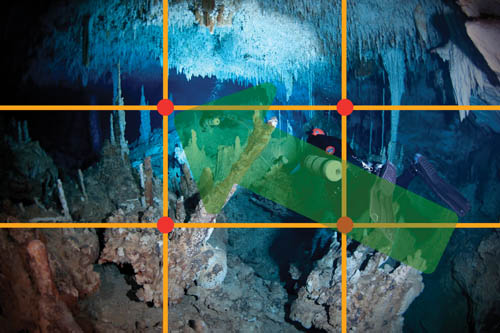Video Composition: The Rule of Thirds
By Jill Heinerth

You’ve carefully selected the destination and spent your hard earned savings to book the dive trip of a lifetime. Painstakingly, you’ve prepared your underwater video system to capture that elusive manta or majestic whale shark you know is out there waiting for your arrival. So, knowing where to place those subjects in the viewfinder can be as important as spotting them in the first place. The unique intuition involved in good composition and proportion can be the difference between a routine video of your underwater experience or a breathtaking visual experience that you can be proud to share with the world on You Tube or Vimeo.
Luckily, you can practice good composition techniques every time you dive and in any conditions. Using your dive buddies as underwater models, you can direct them and their movements through the frame of your viewfinder and through this process learn to develop a sense of good composition.
Frame of Reference
The foundation for outstanding composition in art, photography and videography comes from a basic mathematical principle witnessed in nature. This concept is called the Rule of Thirds. You might have noticed that the viewfinder of your camera offers an option that displays a grid in the frame of reference, dividing it into a tic-tac-toe board with nine cells. By dividing the viewfinder into three columns and three rows, it creates four intersection points where the lines cross inside the frame. The Rule of Thirds tells us that the points of the intersecting lines are the most interesting to the human brain. If your general composition is divided into elements that fall into the thirds, then the action, or strongest area of interest should take place at the intersecting points, with the motion moving into the frame. In underwater shooting that will give the subject, such as the fish or the diver, room to naturally swim into the field of the picture rather than falling out of the edges of the composition. If your subject is constantly pressing against the forward edge of the frame, it is disturbing and seems compositionally ‘off balanced’.
Almost everything in our natural world follows this pattern of design. Whether it is a star nebula or chambered nautilus shell, these elegantly designed works of nature illustrate the Rule of Thirds. As such, it is generally accepted that the human mind finds peace and pleasure in things that follow the golden rules of composition in the natural world. If you examine the human face, it is naturally divided into thirds. In fact, faces of the most attractive models fit tightly within this format. You may have noticed that the Rule of Thirds applies in the most pleasing art, architecture and even web site design.
The human eye rarely rests. Our minds process visual information by bouncing around and grabbing visual snippets of information. If we organize a composition in a way that allows the human brain to follow a logical path to process information, it will be more pleasing. If you simply place your subject in the center of your frame, it is considered bland and static. The viewer’s eye gets drawn to the center of the shot and has no obvious clue about where to go next. With the border of visual information around the subject equal on every side, the viewer’s eye rests on the centre and stays there. This may work for a head shot of a news anchor, but only if the audio content they are reporting is interesting enough to hold the observer’s attention. If you watch the news, you’ll notice that the news anchor is often placed in one third of the frame with a live action video window in another third of the shot. The anchor’s eyes lead the viewer to the inserted video pane.

Stimulate Attention
When you are communicating with visual information only, as is often with underwater videography, then you need to be creative to stimulate the viewer’s attention. By positioning the subject on one of the intersecting points in the Rule of Thirds, it forces the viewer’s eye to roam to find the primary point of interest. If you allow the subject to move diagonally through the frame from one intersection to another, then the viewer’s brain will track with the subject, permitting the illusion of three dimensions. Your video will be more captivating, allowing the viewer to interact and feel like they are participating in the dive. This type of shooting facilitates a shared experience between the videographer and the viewer.
When filming a subject such as a wreck or a reef, you can position your background so that it flows along the horizontal division of cells in the Rule of Thirds, then shoot your models moving through the intersection points either towards or away from the camera. You can also use the lines of a wreck to lead the viewer’s eyes on a diagonal path through the intersections of the Rule of Thirds. When filming a close-up shot with a model, position the model’s eyes in one third of the screen looking down onto a subject at an intersecting point on the opposing third of the frame. By placing the primary focal point (the model’s eyes) in a thirds position, you will be enhancing the photo with a counterpoint in the diagonal position (the close-up subject, such as an anemone) that gives the eye and imagination a place to roam.
The Rule of Thirds is one of the most important to learn when you start shooting. It’s the basis for pleasing, well-balanced and interesting shots. This formula will give you a good compositional foundation allowing for further creativity and exciting footage that sets you apart from the average underwater shooter.
Jill Heinerth is a regular columnist with DIVER, her column appear each issue, so subscribe now and you won’t miss any!
Leave a Comment







